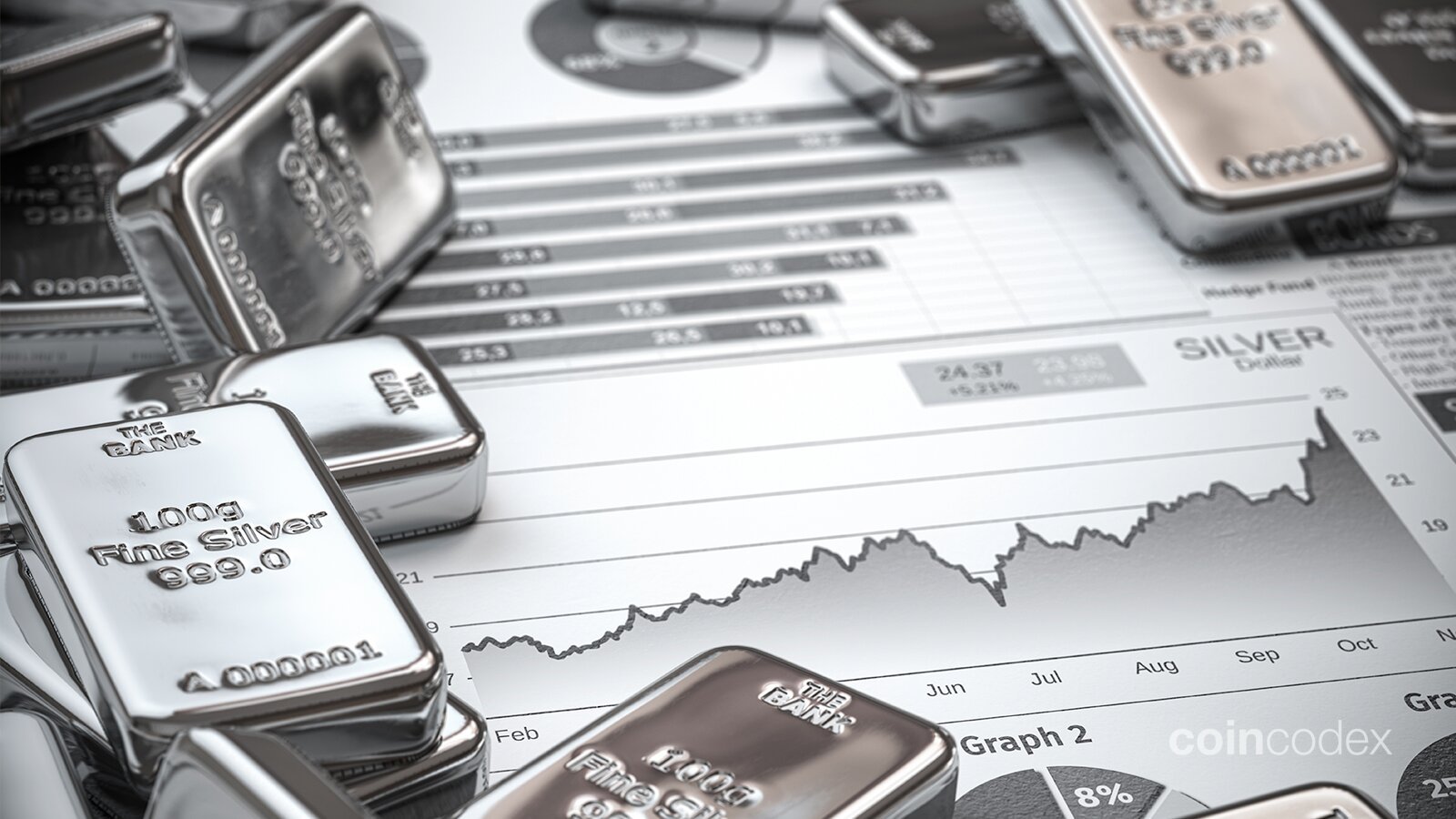The value of a silver bar is determined by the spot price of silver. With an ounce of silver trading at $26.82 as of April 5, 2024, a common type of silver bar weighing 10 oz is worth $268.20.
Silver is the second most widely traded precious metal in the world, behind gold. The value of a silver bar depends on the spot price of silver, the weight of the bar itself, the silver content, and the potential premium charged for the bar.
In this article, we will explore the various aspects that contribute to the worth of a silver bar and provide you with valuable insights into the world of silver investments.
Buy a Silver Bar on BullionByPost
What is a silver bar?
A silver bar is a rectangular-shaped piece of silver that is typically produced in a standardized weight and purity. It is a form of bullion (which is why it’s commonly referred to as silver bullion), which means it is valued primarily for its precious metal content.

A silver bar is essentially a solid block made out of nearly pure silver.
Silver bars are usually made by private mints or government mints and can vary in size and weight, ranging from small bars of a few grams to large bars weighing several kilograms. They are commonly traded and collected as an investment or store of value, as well as for industrial purposes such as manufacturing silverware, jewelry, and electronic components.
How much is a silver bar worth? Factors that determine a silver bar’s worth
The value of a silver bar is derived primarily from its size. The most common type of silver bar, the one troy ounce bar, is changing hands at $26.82 per unit as of April 5, 2024. How much is a bar of silver worth is also determined by the potential premium, which is included in the price of a bar, and other factors. With that said, let’s examine the main factors that contribute to the price of silver bars:
- Silver content: The primary determinant of a silver bar's value is its silver content. Silver bars are typically made of .999 fine silver, meaning they contain 99.9% pure silver. The weight of the bar, usually measured in troy ounces, determines the total amount of silver it holds.
- Spot price of silver: The spot price of silver refers to the current market price at which silver is bought and sold for immediate delivery. It fluctuates based on supply and demand dynamics, economic factors, geopolitical events, and market speculation.
- Premium: The premium represents the additional cost above the spot price that buyers pay to acquire the bar. The premium covers the expenses incurred during the production, distribution, and marketing of the silver bar. It varies depending on factors such as the brand, design, weight, and market conditions – it can range anywhere from 1% to as much as 20%.
- Brand and design: Well-known brands with a strong reputation for producing high-quality bars often command higher premiums. Additionally, limited edition or commemorative bars may have a higher collectible value, attracting collectors and enthusiasts.
- Market conditions: Economic factors, such as inflation, interest rates, and currency fluctuations, can influence the demand for precious metals. During times of economic uncertainty, investors often turn to silver as a safe haven, driving up demand and increasing the value of silver.
How much is a 10 oz bar of silver worth?
A 10 oz silver bar can fetch a price of more than $268.20 at current market prices.
It is worth noting that you can gain exposure to silver without necessarily buying the physical asset itself. For example, you can buy silver-backed cryptocurrency like Kinesis Silver (KAG), which is pegged to the value of 1 oz of silver at a 1:1 ratio.
How much is a 100 oz silver bar worth?
At the time of writing the article, a silver bar weighing 100 oz sells for approximately $2,682. Interestingly, the same-sized gold bar is worth over $202,000, over 80 times more.
How much is a 1-pound silver bar worth?
A 1-pound (lb.) silver bar costs $391.12, given silver’s current spot price of $26.82.
It is worth noting that silver is currently trading close to 50% removed from its all-time high of $49.45, the precious metal reached in January 1980. Still, silver showed impressive performance over the past couple of years, having gained over +75% in the past five years.

The price of silver has increased by more than +50% in the past 5 years. Source: TradingView
How much does a silver bar weigh?
The most common type of silver bar weighs 1 troy ounce (31.1 grams). Other common types of silver bars include 5 oz, 10 oz, and 100 oz.
The table below lists the most common sizes of silver bars, their weights in different weight units, and prices at current rates.
| Weight in troy ounces | Weight in grams | Weight in pounds | Price* |
|---|---|---|---|
| 1 oz | 31.1 g | 0.068 lbs | $26.82 |
| 5 oz | 155.5 g | 0.342 lbs | $134.1 |
| 10 oz | 311 g | 0.686 lbs | $268.2 |
| 100 oz | 3,110 g | 6.857 lbs | $2,682 |
*Based on the spot price of silver of $26.82 (collected on April 5, 2024)
Who makes silver bars?
Silver bars are manufactured by a variety of entities, including government mints, private mints, and precious metals refineries. These organizations specialize in producing silver bars of different sizes and designs to meet the demands of investors and collectors.
Silver bar producers can be roughly divided into three categories, including government mints, private mints, and precious metal refineries. We’ll examine each of these in more detail below:
- Government mints: Government-minted silver bars typically feature iconic national symbols, historical figures, or commemorative designs. Some of the most well-known government mints include the Royal Canadian Mint, the United States Mint, and the Perth Mint.
- Private mints: Private mints are independent companies that produce silver bars for investment and collectible purposes. Some prominent examples of private mints include Swiss-based PAMP Suisse and the US-based Sunshine Minting.
- Precious metals refineries: Refineries source raw silver material, such as silver ore, scrap silver, or silver bullion, and refine it to meet the required purity standards. While they may not directly produce finished silver bars, refineries supply refined silver to mints for further processing. The UK-based Johnson Matthey and Germany-based Heraeus are two of the most prominent silver refining companies.
How to buy a silver bar?
When considering purchasing a silver bar, there are several steps to guide you through the process. First, determine your budget and how much you are willing to invest. This will help narrow down your options as silver bars come in various sizes and weights, each with a different price point.
Next, research reputable dealers who specialize in selling silver bars. It is important to conduct thorough research to ensure the dealer has a track record of customer satisfaction, offers competitive prices, and provides genuine and authenticated products.
Furthermore, make sure to verify the authenticity of silver bars. Genuine silver bars should have a hallmark or stamp indicating their weight, purity, and the mint or refinery that produced them. Reputable dealers will provide authentic products and provide proof of authenticity.
Comparing prices from different dealers is also important to ensure you are getting a fair deal. Keep in mind that prices can vary based on factors such as weight, brand, design, and current market conditions.
Before finalizing the purchase, consider how you plan to store your silver bar. It is important to think about purchasing a secure storage option such as a safe, safety deposit box, or specialized storage facility. Proper storage helps protect your investment and ensures the longevity of the silver bar.
Buy a Silver Bar on BullionByPost
The bottom line: A silver bar’s value depends on its weight, purity, and the spot price of silver
The most common type of silver bar, a 10-troy-ounce silver bar, is currently available for a little more than $268. However, there are quite significant discrepancies in the value of different silver bars, depending on their weight, purity, and premium.
If you are considering gaining exposure to precious metals but don’t want to pay maintenance and storage fees, you can consider investing in gold-backed cryptocurrencies. In addition, if you want to expand your portfolio to other metals with real-world utility, you can consider investing in nickel stocks.






